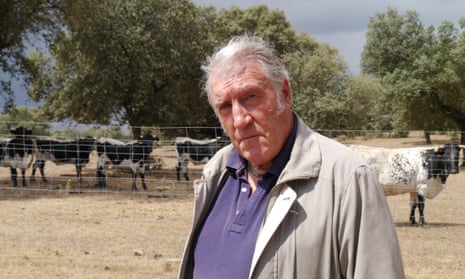A taunting peal of thunder rings out overhead as Diego García de la Peña studies one of his ponds and wonders whether its water will see his cattle through until October.
The 65-year-old farmer – a former bullfighter who quotes Federico García Lorca and whose ancestors were among the legions of steely Extremadurans who bent the New World to their will – is a worried man.
The source of García de la Peña’s anxiety is imprinted on the landscape of his 1,000 hectares (2,471 acres) ranch. Its pastures are dry and pale brown, their grasses short and brittle, and the water level in its 10 ponds is a metre lower than it would be in a good year.
But this is not a good year in Extremadura or elsewhere on the Iberian peninsula. Once again, drought has struck, devastating cereal crops, threatening the olive and grape harvest and leaving livestock short of food and water.
“This is an awful year – the worst we’ve had over the past decade – and it’s one of those that costs you a lot of money,” says García de la Peña. “There’s been no rain – and here, everything depends on the spring and autumn rains.”
His 400 cows may need to be given ready-mixed feed for eight or nine months rather than the usual five, and the water situation is another expensive headache. If the ponds run dry, García de la Peña will have to start sinking wells, around 100 metres deep, in his land. The wells cost €35 a metre to dig and then there are the solar-powered pumps to consider. All in all, he could find himself losing €30,000 (£26,347) this year as he tries to ride out the drought.
“I hope I can make it up next year. I hope I won’t go into the red, but it’s a possibility.”
Things in neighbouring, northwestern Castilla y León are worse still. The drought has ravaged the area, which is known as Spain’s granary, cutting the wheat and barley harvest by 50%.
José Roales, who grows wheat, barley, peas, sunflowers, chickpeas, lentils, and alfalfa in the region’s Zamora province, is one of many staring at an alarming balance sheet. “I’ve been harvesting 1,000kg of cereals per hectare,” the farmer says. “In a normal year I’d get 4,000kg per hectare. The thing is that the first 2,500kg goes on covering my costs. That gives you an idea of how things are this year.”
But, says Roales – who is also the cereals chief of the COAG farming association – others are suffering even more. “Given how things are in other bits of Castilla y León, I still consider myself lucky. In Palencia province, 80% of the cereals haven’t been reaped this year. It’s far, far worse.”
According to the Spanish farming association Asaja, the country is suffering from both a lack of rain over the past five or six years and the gradual diminishing and salinisation of water in aquifers and wells near the coast, which makes irrigation difficult. With the Duero, Segura and Júcar river basins already officially declared to be in drought and some areas seeing 75% less rainfall this year, the focus is now turning to how the drought could affect olives, almonds, pistachios and walnuts.
“All those are tree crops; they have well-established roots that will seek out water deep in the ground, so it will take longer to see how the drought affects them,” says a technical spokesman for Asaja. “It’s going to be a really, really tough year. But we won’t know just how tough until the autumn.”
By then, the drought’s effect on Spain’s vineyards should also be apparent. José Joaquín Vizcaíno, COAG’s representative for the wine-producing sector, says that, while dry years and heat in June can improve grape quality, a prolonged dry spell would be unwelcome. “If this heat continues into August and night-time temperatures are above 20C, ripening will be difficult,” he says.
Vizcaíno believes the high temperatures and lack of rain will see more vineyards turning to irrigation. “The kind of climate change we are seeing year-to-year means that areas in the south, where the rains are shorter, are going to need more irrigation as a back-up during some times of the year, or years when it’s very dry,” he says. “The proportion of irrigated vineyards has grown, and it’s past 40%, nearly at 50%.”
Roales, too, sees the evident and unwelcome hand of climate change at work in his fields. “Older people – say, those over 80 – tell us that 30 years ago winters were harder; it was colder and there was more rain, snow and frost. But as the years have gone by, they’ve grown milder. Where we used to have four seasons, we now have only two: we’re seeing spring and autumn disappear.”
García de la Peña has little choice but to keep on with his cows and the few bulls he raises for the ring. Despite the treacherous climate and the expense of cattle farming, he is ineluctably bound to his land.
“You can put money into a farm until you’re totally and utterly ruined: there are wells to sink and fences and paths to mend. But at the end of the day it’s my life, and I wouldn’t know how to do anything else anyway.
“Maybe if I was 20 I’d be able to change things, but not now. Back when I was fighting bulls, I’d spend all night driving from Nîmes so that I could get back to look after my cows. If you are from the country, you’re from the country.”
The day that the old bullfighter takes off his brown leather riding boots will be the day that he dies. “Maybe we’re the last Romantics,” he says. “I can’t abandon the pastures; they have to carry on being pastures. What would Extremadura be without them?”

Comments (…)
Sign in or create your Guardian account to join the discussion